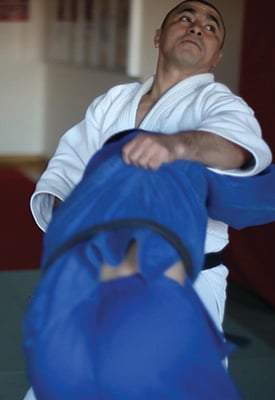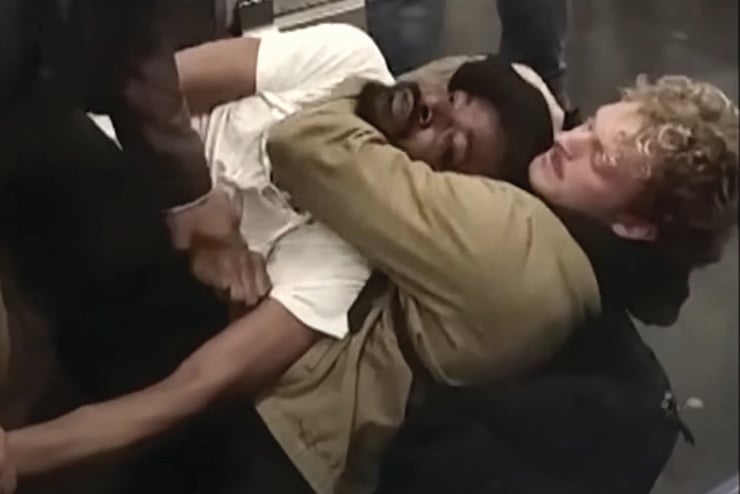(This column was originally published in the August 2023 print edition. Chronicles is republishing it online in October 2024 as the trial of Daniel Penny begins.)
Boredom drove me to fighting. Apparently, I hadn’t received enough concussive pounding from future pros during the four years I masqueraded as a Division I football player. By my late thirties, I had tired of lifting weights. So to kick off yet another midlife crisis, I took up martial arts. Never one to do anything half-speed, I arranged judo lessons with Alisher Mukhtarov, an Uzbekistani judoka who competed at the 1996 and 2000 Summer Olympics. Ali trained me three days per week in the nasty Soviet judo style, doing a job Americans couldn’t do despite his expired visa.
Fifteen years younger, a hundred pounds lighter, and, at 5’4”, a full foot shorter, Ali made it look like I was fighting—and losing to—my long-lost Mongolian love child. Our 90-minute sessions included one hour of live sparring known in Japanese as randori. I estimate that over the years, I attempted to throw Ali roughly 10,000 times during randori. I succeeded once, to his pedagogical delight. He succeeded in countering me with a reverse throw the other 9,999 times. On the plus side, his lack of English forced me to learn enough Russian to let him know when I couldn’t take his beatdowns anymore. ICE rescued me from permanent injury when it deported him in 2017.

Olympic judoka Alisher Mukhtarov
(Mukhtarov’s Facebook page)
To complement my judo, which focuses on fighting on the feet, I also trained at Marcelo Garcia’s Brazilian Jiu-Jitsu (“BJJ”) Academy in Chelsea, which focuses on ground fighting. There too I found private lessons more efficient at compensating for my late-in-life entrée into combat. Matheus Diniz, one of the world’s top middleweight grapplers, agreed to fight with me for two hours per week. While my ground game improved, I perfected “tapping out” thanks to Matheus’s inescapable chokes and joint locks.
My success rate on the BJJ mats matched my success rate on the judo tatami. I submitted Matheus once, by mistake, when he accidentally fell into my
triangle choke. I didn’t realize I even had the choke in place until I noticed him fighting with all his might to escape. Matheus didn’t fear losing consciousness. More likely, he dreaded the idea that his rivals might learn a 53-year-old college professor had submitted him. For my personal safety, I apologized profusely after he tapped out, and then reminded him of the glowing recommendation I had written in support of his pending green card application.
Judo and BJJ group classes rounded out my weekly training. In class I sparred with opponents at different levels. Classes put me in the ring against rank amateurs like myself. But I also faced judo Olympians and national champions from around the world, BJJ national and world champions, and two of the greatest grapplers of all time, Marcelo Garcia and Roger Gracie. Rarely have I experienced the same adrenaline rush and paralyzing fear than the foolhardy times I called out Garcia and Gracie to fight. As scared as I was to throw down with those two greats, I knew that at worst they would “only” snap a joint or choke me unconscious. Lucky for me, Garcia, Gracie, and all my martial arts instructors embodied the best of combat sports: respect for one’s opponent.
Football and fighting both provide lessons that can only be learned on the gridiron, in the octagon, or face to face with evil. Teddy Roosevelt said as much in his 1910 Paris speech “Citizenship in a Republic.” Roosevelt praised “the man who is actually in the arena, whose face is marred by dust and sweat and blood.” This brave fighter fights injustice while pompous critics mock his valiant efforts. The man in the arena has no reason to respect his cowardly detractors, “those cold and timid souls … who shrink from contact with their fellows.”
Unfortunately, cowards abound these days. They use hypocrisy to distract us from their gutlessness, just as Roosevelt noted in Paris. He mocked “those others who always profess that they would like to take action, if only the conditions of life were not exactly what they actually are.” Evolutionary biologist Richard Dawkins argued vigilance improves survival. That rustle in the grass is more likely the wind than a leopard, except when it isn’t.
The low testosterone crowd, none of whom has ever fought anything tougher than their own petty neuroses, has now ganged up on a man who bravely entered the arena of urban mayhem. Daniel Penny, the Marine Corps veteran who choked a menacing fellow subway rider to death in May, needs no introduction thanks to Al Sharpton’s grandstanding, a complicitous media, and a gaggle of personal injury lawyers determined to ruin his life.
A society that euphemizes killing babies as health care and castrating teenagers as gender-affirming care should likewise refer to Penny’s fatal chokehold on Jordan Neely as “crime prevention care.” New Yorkers owe Penny a debt of gratitude for protecting them from physical harm, a duty their government refuses to fulfill. More importantly, Penny’s bravery has sparked an overdue discussion about mental illness, crime, and self-defense in America’s post-Floyd state of lawlessness.
A reasonable person would expect the press to interview other subway riders about their experiences trapped in an enclosed car with a psychotic passenger after Neely’s unfortunate death. Instead, The New York Times tracked down experts who know better than working-class commuters who risk their lives riding with unhinged maniacs. Karim Walker of the Urban Justice Center complained “there was no empathy on that train car” when Neely terrorized other riders with an end-of-his-rope tirade, “I am sick and tired … I don’t care about going to jail and getting a life sentence … I am ready to die.” Christopher Fee—whose name even rhymes with “low-T”—felt qualified to judge the panicked thoughts of Gotham’s sitting duck subway riders all the way from his sinecure professorship in English at Gettysburg College in Pennsylvania. Fee, “who teaches about homelessness” far removed from those of us living under its constant assault, scorned the train full of worrywarts: “Those bystanders may have felt threatened by the victim, but they were not in fact attacked by him.” The Times finally respects rural opinions, provided they come from Ivory Tower goldbrickers.
Another impertinent rural Pennsylvanian, Juniata College social work professor Lee Ann DeShong-Cook, scolded those who feared Neely’s combative behavior. According to the Freud of Huntingdon, Pa., “Had someone simply offered the homeless man a bottle of water or a snack he might have been able to calm down, re-engage his rational brain and would still be alive today.” How exactly does an untrained subway rider re-engage the rational brain of someone in severe psychiatric distress?
Before Neely’s death, city authorities had listed him among the Top 50 neediest mentally ill New Yorkers. One outreach worker correctly predicted in an internal memo that Neely “could be a harm to others or himself if left untreated.” Police had arrested Neely over 40 times. He even had an outstanding warrant when he died of complications from Daniel Penny’s life-saving crime prevention care. Those niggling details didn’t bother Governor Kathy Hochul. As she reminded New Yorkers, “No one has the right to take the life of another person.” Hochul also belongs on New York’s Top 50 list for denying that self-defense justifies killing.
Thankfully, The New York Post tracked down the lone subway rider who witnessed the fatal consequences of Neely’s outburst and who was willing to speak on behalf of all subway riders who just want to get to their destinations unscathed. The unidentified 66-year old woman interviewed by the New York Post thanked Penny for subduing Neely after he scared the hell out of her and other riders that fateful day. The senior citizen provided an account that repudiates the gibberish spewing from rural Pennsylvania’s scholarly aristocrats. “Mr. Penny did not stand up, did not engage with the gentleman. He said not a word. It was all Mr. Neely threatening the passengers if he did not get what he wants.” I guess you had to be there, and not in a cow pasture somewhere in the Keystone State.
Civil liberty ideologues shout down officials who propose to remove the roughly 13,000 severely mentally ill New Yorkers (as estimated by the U.S. Department of Housing and Urban Development) from hurting themselves or others. The New York Civil Liberties Union executive director Donna Lieberman claimed “arrest and forced hospitalization do nothing to address the root drivers of homelessness.” Those of us not beholden to a stultifying reductionism understand that forced hospitalizations protect those who need help the most—the Jordan Neelys—and save the Daniel Pennys from jeopardizing their own lives as the brave men in the arena. We will have more Jordan Neelys, and fewer Daniel Pennys (if he is convicted of second-degree manslaughter), until we involuntarily institutionalize the most ill.
I ride the subway every day. Unlike social work professors on bucolic campuses and governors who travel with armed guards, I fear for my life every time a psychopath takes over a subway car. As scared as I am fighting in the controlled conditions of combat sports, I am far more terrified when a madman rants that he’s got nothing to lose. I look at other passengers, knowing most will have no chance if they’re attacked.
I knew that Alisher Mukhtarov would never stab me. I knew that Matheus Diniz would never shoot me. And I knew that neither Marcelo Garcia nor Roger Gracie would ever bite me or infect me with tuberculosis. Those deadly risks occupy my entire mental bandwidth once the predictable, deranged screaming interrupts my daily subway reading. Daniel Penny, today’s man in the arena, removed a threat the authorities proved too cowardly to remove themselves. Sadly, Jordan Neely was too sick to tap out. ◆

Leave a Reply